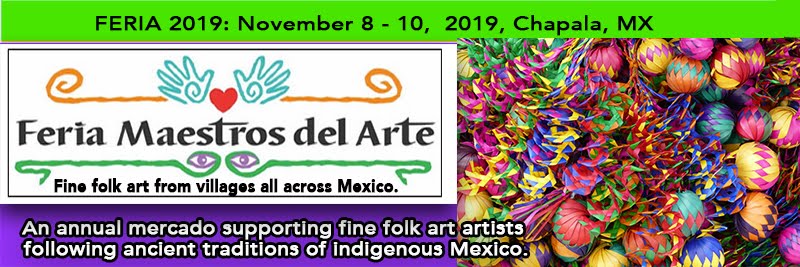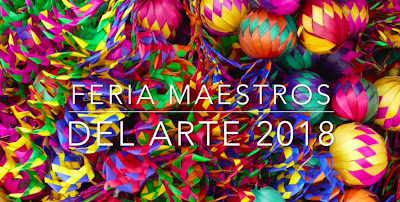 |
| 2017 Artista from Chiapas |
When you come to Feria Maestros del Arte, you will be seeing more than Mexican folk art and colorful costumes. You will be meeting Mexico in a way few travelers do.
For instance, several days before the Feria, Zenaida Hernández Gómez and Cristina Hernández Pérez have been packing and organizing the textile works from the 50 women who make up Compa Lucha, a cooperative from villages in the municipality of Chenalhó. Zenaida and Cristina are from the village of Yaxgemel Unión, population 362, which is an Abejas community. They will join 40 other artists from Chiapas for a long bus ride to the Feria where each artist will set up their woven and embroidered textiles, pottery, hand carved kitchen utensils, jewelry, rugs, and much more.
 |
| Textiles from Compa Lucha |
If you wanted to visit them, you would most likely fly into the modern airport outside Tuxtla Gutiérrez, a bustling capital city of 500,000 and home of the marimba, and then drive, take a bus or taxi into the highlands where the stunning, colonial city of San Cristóbal de las Casas sits at 2200 meters (7200 feet). As you're enjoying the beauty, history and food of this cultural capital of Chiapas, it will be a challenge to remember that in 1994, the revolutionary Zapatistas took over the city.
 |
| The long trip from Chiapas to Chapala |
Continuing the journey to Yaxgemel, you would leave San Cristóbal and drive into the sparsely populated, mountainous backroads of Mexico. Eventually, you would reach Chenalhó, a town of about 3,000. From there you would have to ask directions from the locals, most of whom don’t speak English or Spanish, because Yaxgemel isn’t on Google Maps.
Of course, you could also just come to the beautiful yacht club in Chapala and meet Zenaida and Cristina in person and see their incredible rebozos, huipils and other hand made and embroidered items. If you have time and find one of the many Spanish-speaking Feria volunteers to help you, you could also ask them about being part of an Abejas community. Abejas, “the bees” is a Christian pacifist civil society group of Tzotzil Maya formed in Chenalhó in 1992 following a property dispute that left one person dead and a controversy about who was at fault.
When the Zapatista Army of National Liberation uprising took place in 1994, Las Abejas stood in solidarity with the the principles they were fighting for, but not their violent means, and paid a high price for their support when 45 of their members were massacred while praying in a church.
Zenaida and Cristina represent only one story and one form of folk art you will encounter at the Feria. There are 83 other booths of authentic Mexican folk art and artisans from all over Mexico with their own stories and art handed down through the generations. To help visitors understand more of the deep background of this art and the artisans who make it, the Feria is presenting a series of speakers and demonstrations to meet the artists and understand the stories behind their art. There will be two presentations each day of the Feria, morning and afternoon. Here is the schedule:
*** Friday 11/9
10:30-11:30 Guadalupe Garcia Rios - Ceramics (Tent 1)
2:30-3:30 Jacobo Mendoza - Rug Weaver (Tent 1)
*** Sat 11/10
10:30-11:30 Dream Weavers - Weavers & Dyers (Tent 1)
2:30-3:30 Martha Turok - Special Guest: Rebozos and sarapes,
two emblematic garments at risk (Tent 1)
*** Sunday 11/11
10:30-11:30 Martha Turok - Special Guest: Challenges of
sustainability and natural dyes (Tent 1)
2:30-3:30 Cilau Valadez- Huichol yarn paintings (Tent 1)
So, when you come to the Feria, not only will you meet Mexico in three days, you will be playing a part in saving Mexican folk art for the future. In small villages all over Mexico, families are making beautiful art. The Feria is a non-profit organization that charges no fees or commissions and pays for all the transportation costs for the artists.
All of the money the artists earn at the Feria goes home with them, and, for many of the artists, the Feria is their major source of income for the year. Your purchases represent more than beautiful things, they are a connection to real people, real stories from actual families living in remote villages, working every day to bring their art to you during this one three-day event every year.
Please join us: Feria Maestros del Arte, November 9-11, 2018. Chapala Yacht Club.
































